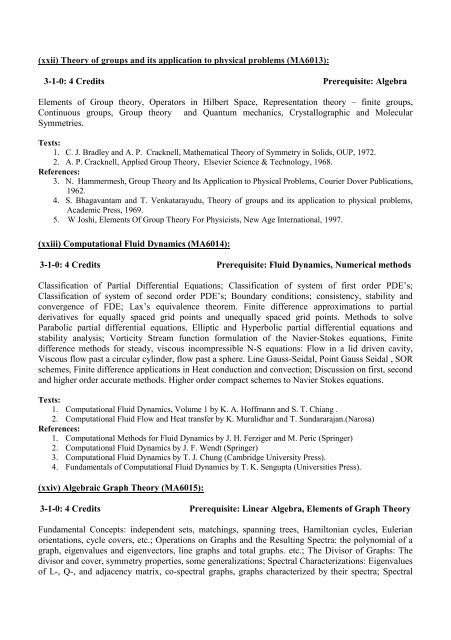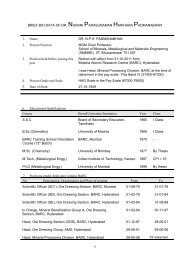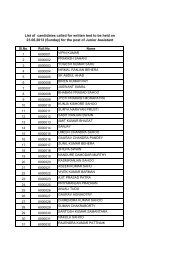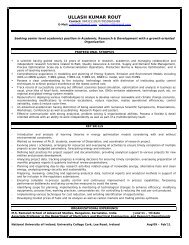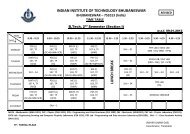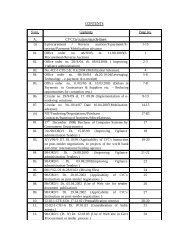(xx) Time Series Analysis <strong>and</strong> Forecasting (MA6011):3-1-0: 4 Credits Prerequisite: Probability <strong>and</strong> StatisticsStochastic <strong>and</strong> deterministic mathematical models for forecasting <strong>of</strong> time series, Classical techniquesin Time Series Analysis, Different Smoothing Techniques, General linear process, Autoregressiveprocess AR(P), Moving average process Ma(q): Autocorrelation, Partial autocorrelation, <strong>and</strong>Spectrum, Linear stationary models for autoregressive moving average processes, Mixedautoregressive moving average processes, Autocovariances, Autoregressive Integrated MovingAverage Processes (ARIMA).Forecasting, Calculating <strong>and</strong> updating forecast, Forecast function <strong>and</strong> forecast weight, Examples <strong>of</strong>forecast functions <strong>and</strong> their updating, Identification in time domain, Model Identification , Estimation<strong>of</strong> Parameters, Model estimation, Non-linear estimation, Model diagnostic checks, Seasonal models,Transfer function models, Discrete transfer function model, continuous dynamic models,Identification, fitting <strong>and</strong> checking <strong>of</strong> transfer function models, Intervention analysis models <strong>and</strong>outlier detection, Estimation <strong>of</strong> Autoregressive moving average (ARMA) models, Use <strong>of</strong> time seriestechniques in Engineering fields.Texts/ References:1. George Box, Gwilym M. Jenkins <strong>and</strong> Gregory Reinsel, Time Series Analysis: Forecasting & Control,3/E Pearson Education India, 1994.2. Douglas C. Montgomery, Cheryl L. Jennings, Murat Kulahci, Introduction to Time Series Analysis <strong>and</strong>Forecasting, John Wiley & Sons, 2011.(xxi) Mathematical theory <strong>of</strong> Elasticity (MA6012):3-1-0: 4 Credits Prerequisite: NilAnalysis <strong>of</strong> strain, deformation, affine deformation, infinitesimal affaine deformation, geometricalinterpretation <strong>of</strong> the components <strong>of</strong> strain, principal directions, invariants, general infinitesimaldeformation, Examples <strong>of</strong> strain, strain compatibility equations; Analysis <strong>of</strong> stress, body <strong>and</strong> surfaceforces, stress tensor, equations <strong>of</strong> equilibrium, stress quadric <strong>of</strong> Cauchy, examples <strong>of</strong> stress; Thestrain – energy function <strong>and</strong> its connection with hooks law, Saint Venant's principle. Boundary valueproblems in elasticity; Extension, bending <strong>and</strong> Torsion: statement <strong>of</strong> problem, extension <strong>of</strong> beams bylongitudinal forces, Beam stretched by its own weight, Bending <strong>of</strong> beams by terminal couples <strong>of</strong>elliptic cylinder, Torsion <strong>of</strong> a circular shaft, Torsion <strong>of</strong> cylindrical bars, stress function, Torsion <strong>of</strong>elliptical cylinder; Two-dimensional elastostatic problems: plane deformation, plane stress,Generalized plane stress, plane elastostatic problems, Airy’s stress function, General solution <strong>of</strong>Biharmonic equation, formulas for stresses <strong>and</strong> displacements, the structure <strong>of</strong> the functions ø(z) <strong>and</strong>φ(Z); Vibration <strong>of</strong> elastics solids, wave propagation in infinite regions, Ryleigh <strong>and</strong> Love waves .Texts:1. I.S.SOKOLINIKOFF, Mathematical theory <strong>of</strong> Elasticity; Tata McGraw Hill, 1972.2. Martin H. Sadd, Elasticity: Theory, Applications, <strong>and</strong> Numerics; Elsevier Butterworth Heinman, 2005.
(xxii) Theory <strong>of</strong> groups <strong>and</strong> its application to physical problems (MA6013):3-1-0: 4 Credits Prerequisite: AlgebraElements <strong>of</strong> Group theory, Operators in Hilbert Space, Representation theory – finite groups,Continuous groups, Group theory <strong>and</strong> Quantum mechanics, Crystallographic <strong>and</strong> MolecularSymmetries.Texts:1. C. J. Bradley <strong>and</strong> A. P. Cracknell, Mathematical Theory <strong>of</strong> Symmetry in Solids, OUP, 1972.2. A. P. Cracknell, Applied Group Theory, Elsevier Science & <strong>Technology</strong>, 1968.References:3. N. Hammermesh, Group Theory <strong>and</strong> Its Application to Physical Problems, Courier Dover Publications,1962.4. S. Bhagavantam <strong>and</strong> T. Venkatarayudu, Theory <strong>of</strong> groups <strong>and</strong> its application to physical problems,Academic Press, 1969.5. W Joshi, Elements Of Group Theory For Physicists, New Age International, 1997.(xxiii) Computational Fluid Dynamics (MA6014):3-1-0: 4 Credits Prerequisite: Fluid Dynamics, Numerical methodsClassification <strong>of</strong> Partial Differential Equations; Classification <strong>of</strong> system <strong>of</strong> first order PDE’s;Classification <strong>of</strong> system <strong>of</strong> second order PDE’s; Boundary conditions; consistency, stability <strong>and</strong>convergence <strong>of</strong> FDE; Lax’s equivalence theorem. Finite difference approximations to partialderivatives for equally spaced grid points <strong>and</strong> unequally spaced grid points. Methods to solveParabolic partial differential equations, Elliptic <strong>and</strong> Hyperbolic partial differential equations <strong>and</strong>stability analysis; Vorticity Stream function formulation <strong>of</strong> the Navier-Stokes equations, Finitedifference methods for steady, viscous incompressible N-S equations: Flow in a lid driven cavity,Viscous flow past a circular cylinder, flow past a sphere. Line Gauss-Seidal, Point Gauss Seidal , SORschemes, Finite difference applications in Heat conduction <strong>and</strong> convection; Discussion on first, second<strong>and</strong> higher order accurate methods. Higher order compact schemes to Navier Stokes equations.Texts:1. Computational Fluid Dynamics, Volume 1 by K. A. H<strong>of</strong>fmann <strong>and</strong> S. T. Chiang .2. Computational Fluid Flow <strong>and</strong> Heat transfer by K. Muralidhar <strong>and</strong> T. Sundararajan.(Narosa)References:1. Computational Methods for Fluid Dynamics by J. H. Ferziger <strong>and</strong> M. Peric (Springer)2. Computational Fluid Dynamics by J. F. Wendt (Springer)3. Computational Fluid Dynamics by T. J. Chung (Cambridge University Press).4. Fundamentals <strong>of</strong> Computational Fluid Dynamics by T. K. Sengupta (Universities Press).(xxiv) Algebraic Graph Theory (MA6015):3-1-0: 4 Credits Prerequisite: Linear Algebra, Elements <strong>of</strong> Graph TheoryFundamental Concepts: independent sets, matchings, spanning trees, Hamiltonian cycles, Eulerianorientations, cycle covers, etc.; Operations on Graphs <strong>and</strong> the Resulting Spectra: the polynomial <strong>of</strong> agraph, eigenvalues <strong>and</strong> eigenvectors, line graphs <strong>and</strong> total graphs. etc.; The Divisor <strong>of</strong> Graphs: Thedivisor <strong>and</strong> cover, symmetry properties, some generalizations; Spectral Characterizations: Eigenvalues<strong>of</strong> L-, Q-, <strong>and</strong> adjacency matrix, co-spectral graphs, graphs characterized by their spectra; Spectral
- Page 5: Distribution of Credits (Mathematic
- Page 9 and 10: Credit StructureRecommended Actual1
- Page 11 and 12: Sr. No. Course Name Nature of cours
- Page 13 and 14: List of subjects to be floated unde
- Page 15 and 16: Detail SyllabusSemester-ITotal Cred
- Page 17 and 18: esiduals, Multiple regression, Anal
- Page 19 and 20: 9. Complex Analysis (MA4007):3-0-0:
- Page 21 and 22: 14. Seminar II (MA4402):0-0-3: 2 Cr
- Page 23 and 24: 19. Elective I:3-0-0: 3 CreditsOne
- Page 25 and 26: oots; Diophantine equations: linear
- Page 27 and 28: theorems on constants, equivalence
- Page 29 and 30: variables. Integration on chains, t
- Page 31 and 32: equivalence of fractals; Multifract
- Page 33: References:3. Neural Networks,Fuzzy
- Page 37 and 38: Texts:1. M. Brin and G. Stuck, Intr
- Page 39 and 40: network simplex, interior point met
- Page 41 and 42: 3. J N Kapur, Mathematical Models i
- Page 43 and 44: Credit StructureRecommended Actual1
- Page 45: COURSE CURRICULUMSl. No. Course Nam
- Page 48 and 49: xxii Chemical Bonding and Reactivit
- Page 50 and 51: concept of organic compounds; Ideal
- Page 52 and 53: (9) Principles of Organometallic an
- Page 54 and 55: Expt. 11. To determine the λ O and
- Page 56 and 57: For course detail belongs to Electi
- Page 58 and 59: (v) Metal Complexes in Catalysis (C
- Page 60 and 61: (x) Chemistry of Materials (CY6010)
- Page 62 and 63: 2. M. Smith, Organic Synthesis, Mc
- Page 64 and 65: sugars, Nucleosides, nucleotides, C
- Page 66 and 67: 1. Helmut Kronmüller (Editor), Stu
- Page 68 and 69: 2. R. D. Guthrie and J. Honeyman, A
- Page 70 and 71: and diastereoselectivity. Condition
- Page 72 and 73: PHYSICS
- Page 74 and 75: Semester-wise course detailsSemeste
- Page 76 and 77: LIST OF ELECTIVESList of subjects t
- Page 78 and 79: (3) Quantum Mechanics I (PH4003):3-
- Page 80 and 81: References:1. Taylor, John R., An I
- Page 82 and 83: (12) Electrodynamics II (PH4011):3-
- Page 84 and 85:
electrons in a periodic potential;
- Page 86 and 87:
driven systems of interacting parti
- Page 88 and 89:
(vii) Quantum Field Theory (PH6007)
- Page 90 and 91:
5. D. Green, The Physics of Particl
- Page 92:
Numerical solutions of Schrodinger
- Page 95 and 96:
Semester ISl.No.Subject NameLoading
- Page 97 and 98:
ElectivesSl. No. Subject Name Loadi
- Page 99 and 100:
L-T-P: 3-0-0Dynamic and kinematic a
- Page 101 and 102:
Groundwater contamination, sources
- Page 103 and 104:
Hydrocarbons L-T-P: 3-0-0Fundamenta
- Page 105 and 106:
3. Principles of Stable Isotope Geo
- Page 107:
Books:1. A Handbook of Silicate Roc


